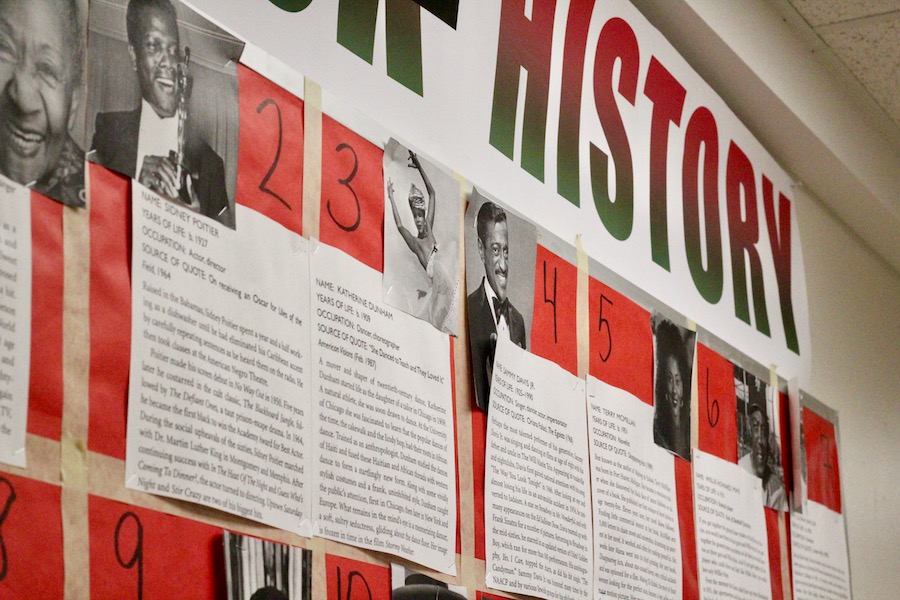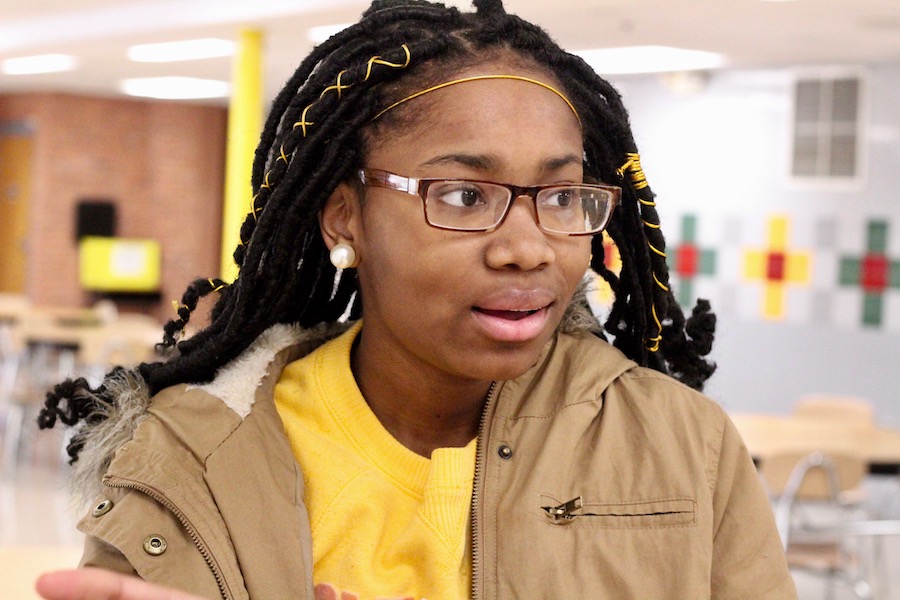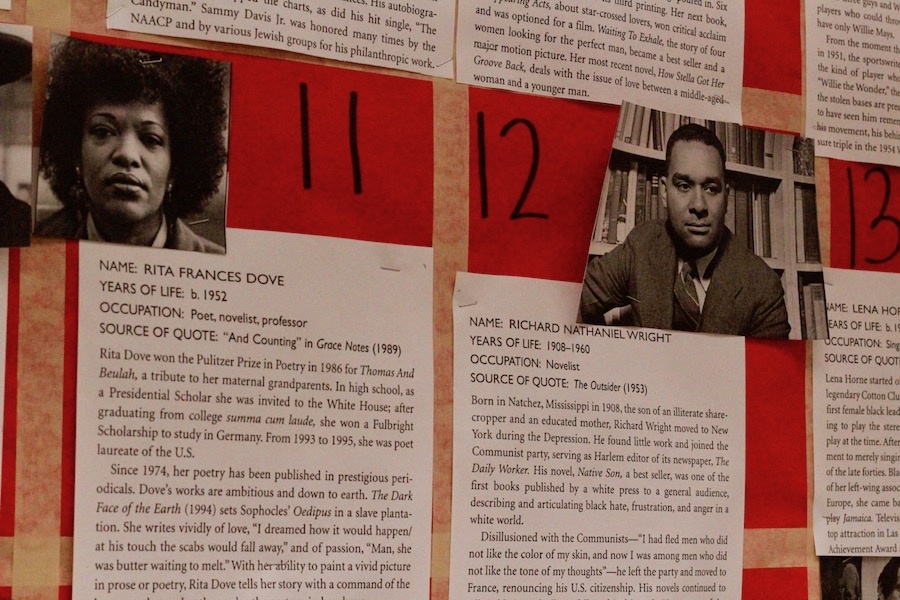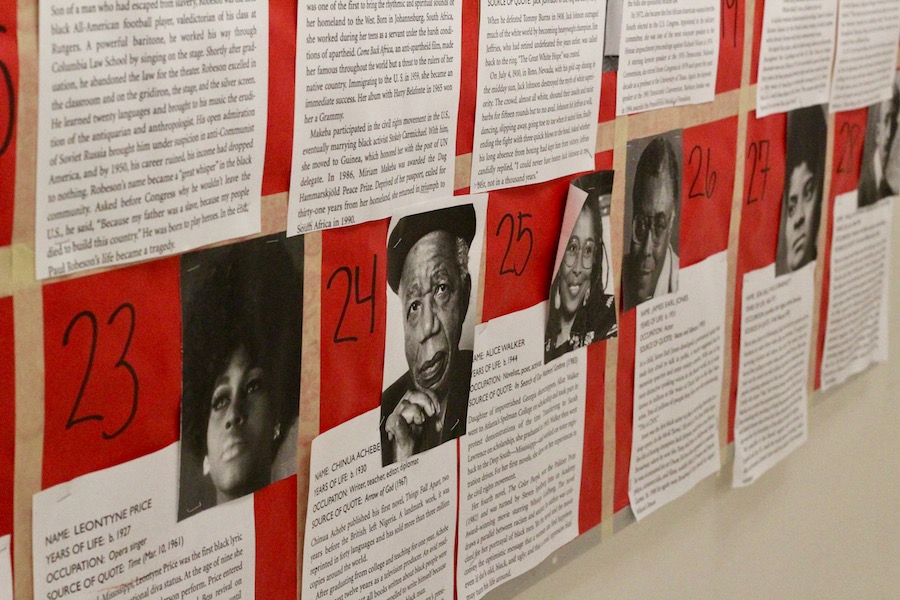
The 28 pairs of eyes don’t have a starting point.Lucy Gellman Photos.
The 28 pairs of eyes don’t have a starting point. Katherine Dunham leans back, the carriage of her arms nearly a perfect U above her head. Paul Robeson is looking at something off to his left that we can’t see, suspended outside the borders of the picture. Leyonte Price is regal, eyes turned upward, afro encircling her face. Her earrings glint even in black and white. Gordon Parks is too busy to look at us. He’s got his camera rolling in one hand, and has his eyes locked on whatever it is capturing.
They’re part of a new, large display at High School in the Community (HSC) celebrating 28 Black Americans—14 men and 14 women—in the arts, humanities, sciences, and sports. Organized by 17-year-old Ny’Asia Davis, a senior who serves as president as student council, the display hangs in the cafeteria, where it will stay after February has ended.

Ny’Asia Davis: Vote for me in 2044.
The display wasn't originally part of HSC’s administrative plan or its annual curriculum. But when Davis watched Black History Month activities fall apart at the beginning of February, she decided to take matters into her own hands.
In January, the student council had voted to have morning shout-outs to Black Americans—two a day, from a rotating cast of students who were interested in presenting. They’d also voted to hold a ‘town meeting’ for the second year in a row, discussing past and present Black history in a large group. But Davis was skeptical.
“From our spirit week, I noticed that there’s a lot of miscommunication,” she recalled Tuesday afternoon, sun streaming through HSC’s back windows. “I lot of people say ‘Oh, I’m gonna do this,’ but then it doesn’t get done, or it gets left to the last minute.”
That’s ultimately what happened, Davis said. A classmate dropped her duties at the last minute. It wasn’t clear how many might follow. And Davis decided that “Yeah, I’m not gonna do this.”
She went to Christian Shaboo, HSC’s ‘Dream Director’ through The Future Project. Inspired by her history teacher Jack Stacey, she already could see the project set in her head: a February calendar of 28 historical figures who she saw as left out of Black History Month discussions, like writers Alice Walker, Zora Neale Hurston, Derek Walcott and Lucille Clifton, Political Scientist Ralph Bunche, playwright Richard Wright, civil rights activist Dick Gregory. To narrow down her list, she spent hours with Stacey’s deck of “history cards.”

“I sat there for a whole period just sorting out the people that I wanted,” she recalled. “I didn’t want too many of the same thing—like I didn’t want too many musicians, because there’s a lot of musicians. And I didn’t want too many writers. So I tried to find a balance between different jobs. And I also did 14 men and 14 women.”
As the list grew, so did her ideas about mounting it. After printing out all of the images with Shaboo, she and her friend Kiana Nhem spent a weekend arranging, rearranging, and stapling the display into place in the school cafeteria. Although Davis wanted it to be a surprise for the student body, she recalled telling a few friends beforehand, too excited to keep it completely secret. Shaboo printed out a banner for the top that read “Black History.”
It took Davis and Nhem hours to get the photos and biographical labels exactly where they wanted them. As a finishing touch, Davis placed a blocky black line through the word “Black.” Sharing a photo of the display to social media, she and HSC Curriculum Leader Cari Strand both added a hashtag to clarify its presence: #BlackHistoryIsAmericanHistory.
“I wanted to get across that Black history, yeah, is comprised of African-Americans in the past and stuff, but it’s also history,” Davis said. “Why is it separated as something different? It’s all American history.”

It’s a fuller version of American history as she hopes it will one day be taught, Davis added. Not included are historical figures who she has seen get a lot of airtime—Martin Luther King Jr., Rosa Parks, Malcom X. She said she had to fight fellow student council members on that choice (“It wasn’t a debate, but it kind of got heated!”) but that it only strengthened her resolve to highlight figures that her classmates may not yet know.
“I’m like: No!” she recalled. “We know who those people are. We know what they did. We don’t know about other people who played parts like them or did other things.”
Now, she said she hopes to see the display stay up through June, when she graduates and heads to college. As of Tuesday, she had just been accepted to eight schools including Clark Atlanta University—her first choice—and was already thinking about how her background leading the student body might catapult her into a Political Science major.
“You can vote for me in 2044,” she said smiling, before noting that she feels conflicted about mounting the display during Black History Month, but ultimately decided it was the best thing to do for the student body.
.jpg)
From left to right: students Tyron Houston, Mike Pauta, and Jano Johnson.
“Black History month is every month,” she said, invoking the words of her friend Jeremy Cajigas, founder of the community group Fighters for Justice. “But something we really wanted to emphasize was … we can’t just say that it’s every single month. Because February is the month that people celebrate it. So we don’t want to take away from that.”
“If we say we’re not gonna celebrate in February, everybody else is going to forget about it, and we’re never gonna talk about it,” she added. “Because it doesn’t get talked about throughout the year.”
Downstairs, three fellow students sang in a chorus of agreement as they passed through the cafeteria. Davis perched on the edge of a table staring at her favorite figure, Sammy Davis, Jr. Above a big, crinkly bow tie, he looked back at her, beaming.
“It’s definitely different,” said senior Mike Pauta. “We know Martin Luther King, but we don’t know, like, these other people.”
“Yeah,” said fellow student Tyron Houston. “Black History Month is the only time you are told things like this exist.”